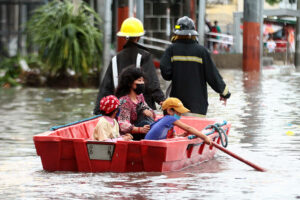Filipinos are more prepared for natural disasters than they were seven years ago, but material investments and social support still needs improvement, according to a nationwide survey conducted between February to March 2024 by the Harvard Humanitarian Initiative (HHI).
On average, Filipinos’ self-reported disaster preparedness level increased by 42%, as revealed by the HHI survey on disaster preparedness and climate change perceptions in the Philippines.
The average score – 19.2 out of 50 points – was an improvement over the 13.5 out of 50 gleaned in a 2017 study conducted by HHI using the same methodology and instrument.
“For a country as vulnerable to disasters as the Philippines, [however,] this is not enough,” Vincenzo Bollettino, director of the HHI Resilient Communities program and co-lead for this study, said.
“A score of 19.2 highlights both progress and areas needing urgent attention,” he said in a November 7 press statement.
“The score suggests that Filipinos are only doing 38.4% of the kinds of disaster preparedness activities needed to be prepared,” he added.
Among the five objective measures of disaster preparedness, Filipinos scored highest in information (4.9 out of 10) and lowest in social support (2.3 out of 10).
In terms of specific social support activities, less than a quarter of Filipinos are members of a group or association (23%) and are familiar with their local disaster risk reduction and management officers (16%).
Social support also declined to 2.3 in 2024 from 2.7 out of 10 in 2017.
While many Filipinos discuss emergency plans as a family (58%), less than a third prepare their respective disaster management plan (20%), Go bag (27%), adequate supplies of regularly taken medications (32%), and first aid kit (33%).
Regions-wise, the Cordillera Administrative Region (24.0 out of 50), Central Visayas (21.5), and Western Visayas (21.4) reported the highest levels of preparedness. Davao Region (17.3), Negros Island (15.8), and Bangsamoro Autonomous Region in Muslim Mindanao or BARMM (15.1), on the other hand, reported the lowest levels of such preparedness.
The Philippine capital of Metro Manila ranked 11th in level of disaster preparedness (19.1) and slightly below the national average (19.2). It is also one of the regions with the least progress in disaster preparedness over time, with an increase in preparedness score by 22%, or 3.4 points from 15.7 in 2017.
“The [National Capital Region] is the heart of the Philippine economy and home for a significant part of the country’s population, yet it is routinely hit by natural hazards,” Mr. Bollettino said. “Increasing its disaster preparedness is crucial.”
The Philippines has the highest disaster risk in the world, based on the 2024 WorldRiskReport.
As Patrick Vinck, HHI’s director of research, said: “enhancing the Philippines’ disaster preparedness requires investing in local leadership and leveraging technology to improve early warning systems and community engagement, among other critical measures.”
“This should be accompanied by investments in resilient infrastructures, local capacities, and anticipatory actions,” he said in the same November 7 press statement. – Patricia B. Mirasol
